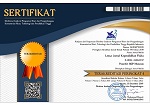Synthesis and Characterization of TiO2 Semiconductor Doped by AgNO3 and Their Application as Photoanode in Dye-sensitized Solar Cells
Abstract
Keywords
Full Text:
PDFReferences
Anita, A., Boisandi, B., Nurussaniah, N., Cari, C., & Suharyana, R. (2013). Karakteristik Klorofil Pada Daun Kacang Panjang (Vigna Sinensis) sebagai Dye-Sensitized Solar Cells. Paper presented at the lpf2013.
Asahi, R., Morikawa, T., Ohwaki, T., Aoki, K., & Taga, Y. (2001). Visible-light photocatalysis in nitrogen-doped titanium oxides. Science, 293(5528), 269-271.
Cheng, C.-K., Lin, C.-H., Wu, H.-C., Ma, C.-C. M., Yeh, T.-K., Chou, H.-Y., . . . Hsieh, C.-K. (2016). The two-dimensional nanocomposite of molybdenum disulfide and nitrogen-doped graphene oxide for efficient counter electrode of dye-sensitized solar cells. Nanoscale research letters, 11(1), 117.
Distyawan, A., & Susanti, D. (2013). Pengaruh Temperatur, Massa Zink, Substrat Dan Waktu Tahan Terhadap Struktur Dan Morfologi Zno Hasil Sintesis Dengan Metode Chemical Vapour Transport (CVT). Jurnal Teknik ITS, 2(2), F336-F341.
Ekasari, V., & Yudoyono, G. (2013). Fabrikasi DSSC dengan dye ekstrak jahe merah (Zingiber officinale linn var. rubrum) variasi larutan TiO2 nanopartikel berfase anatase dengan teknik pelapisan spin coating. Jurnal Sains dan Seni ITS, 2(1), B15-B20.
Fatimah, S., & Haris, A. (2014). Pengaruh Dopan Zink Oksida pada TiO2 terhadap Penurunan Kadar Limbah Fenol dan Cr (VI) secara Simultan dengan Metode Fotokatalisis. Jurnal Kimia Sains dan Aplikasi, 17(3), 86-89.
Grätzel, M. (2003). Dye-sensitized solar cells. Journal of photochemistry and photobiology C: Photochemistry Reviews, 4(2), 145-153.
Irmansyah, I., Maddu, A., & Zuhri, M. (2008). Fabrication and Characterization Dye-Sensitized Solar Cell based on TiO2/SnO2 Composit Electrode and Polymer Electrolite. Jurnal ILMU DASAR, 9(2), 96-103.
Kao, C.-C., Kuo, H.-C., Yeh, K., Chu, J., Peng, W., Huang, H., . . . Wang, S. (2007). Light–output enhancement of nano-roughened GaN laser lift-off light-emitting diodes formed by ICP dry etching. IEEE Photonics Technology Letters, 19(11), 849-851.
Karim, S., Pardoyo, P., & Subagio, A. (2016). Sintesis dan Karakterisasi TiO2 Terdoping Nitrogen (N-Doped TiO2) dengan Metode Sol–Gel. Jurnal Kimia Sains Dan Aplikasi, 19(2), 63-67.
Masakke, Y., & Rasyid, M. (2015). Biosintesis Partikel-nano Perak Menggunakan Ekstrak Metanol Daun Manggis (Garcinia mangostana L.). Sainsmat: Jurnal Ilmiah Ilmu Pengetahuan Alam, 4(1).
Mo, S.-D., & Ching, W. (1995). Electronic and optical properties of three phases of titanium dioxide: Rutile, anatase, and brookite. Physical Review B, 51(19), 13023.
Nadaek, S. M., & Susanti, D. (2012). Variasi temperatur dan waktu tahan kalsinasi terhadap unjuk kerja semikonduktor TiO2 sebagai dye sensitized solar cell (DSSC) dengan dye dari ekstrak buah naga merah. Jurnal Teknik ITS, 1(1), F81-F86.
Septina, W. (2007). Sintesa Nanokristal Mesopori TiO2 dengan Metoda Sol-Gel: Bandung: Institut Teknologi Bandung.
Šileikaitė, A., Prosyčevas, I., Puišo, J., Juraitis, A., & Guobienė, A. (2006). Analysis of silver nanoparticles produced by chemical reduction of silver salt solution. Mater. Sci, 12(4), 1392-1320.
Umar, A. A., Saad, S. K. M., Umar, M. I. A., Abd Rahman, M. Y., & Oyama, M. (2018). Advances in porous and high-energy (001)-faceted anatase TiO2 nanostructures. Optical Materials, 75, 390-430.
Umar, M. I. A. (2019). Graphene-Au Film Synthesized from GrO in Au-Aquaeus Solution as Counter Electrode For DSSC Application. Lensa: Jurnal Kependidikan Fisika, 7(2), 24-30.
Umar, M. I. A., Yap, C. C., Awang, R., & Salleh, M. M. (2017). Effect of thermal reduction temperature on the optical and electrical properties of multilayer graphene. Journal of Materials Science: Materials in Electronics, 28(1), 1038-1041.
Zamrani, R., & Gontjang, P. (2013). Pembuatan Dan Karakterisasi Prototipe Dye Sensitized Solar Cell (DSSC) Menggunakan Ekstraksi Kulit Buah Manggis Sebagai Dye Sensitizer Dengan Metode Doctor Blade. Jurnal Sains Dan Seni Pomits, 1(2).
DOI: https://doi.org/10.33394/j-lkf.v8i1.2728
Refbacks
- There are currently no refbacks.

This work is licensed under a Creative Commons Attribution-ShareAlike 4.0 International License.

Lensa: Jurnal Kependidikan Fisika is licensed under a Creative Commons Attribution-ShareAlike 4.0 International License.


.png)
